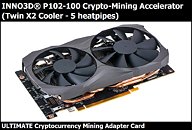Tuesday, March 13th 2018

NVIDIA P102-100 Cryptomining Graphic Card Surfaces
The truth of the matter is that the cryptocurrency boom isn't losing strength yet, and graphics card manufacturers are more than happy to profit off this phenomenon. However, one must have the right tools to mine cryptocurrency effectively. NVIDIA is keen to provide cryptominers with the necessary hardware as they ready their latest GP102-100 card for launch. The GP102-100 should sound familiar to most enthusiasts since it employs the same GP102 chip used in the mainstream GeForce GTX 1080 Ti and GTX Titan Xp graphics cards. Nevertheless, NVIDIA made a few modifications in order to maintain the hash rate while lowering the price at the same time. In other words, we're basically dealing with a gimped version of the GP102 chip with less memory channels, shader cores, and memory.
The Inno3D P102-100 is the first model to show up in the wild. The card packs 3,200 CUDA cores clocked at 1582 MHz and 5 GB of GDDR5X memory operating at 10 Gbps across a 320-bit wide memory interface. Inno3D is utilizing their Twin X2 cooling solution to cool the card. This solution features five heatpipes to draw the heat away from the GPU and two fans to provide active cooling. Being a mining-oriented model, the Inno3D P102-100 lacks a bracket and display outputs. It also only requires four PCIe lanes to function. The Inno3D P102-100 has a 250W TDP rating and draws power from a pair of 8-pin PCIe power connectors. According to Inno3D, their card is capable of mining Ethereum with a hash rate of 47 MH/s which easily beats a GeForce GTX 1080 Ti and GTX Titan Xp. Pricing is unknown at the writing of this article.Inno3D P102-100 Specifications
Source:
Hardware.Info
The Inno3D P102-100 is the first model to show up in the wild. The card packs 3,200 CUDA cores clocked at 1582 MHz and 5 GB of GDDR5X memory operating at 10 Gbps across a 320-bit wide memory interface. Inno3D is utilizing their Twin X2 cooling solution to cool the card. This solution features five heatpipes to draw the heat away from the GPU and two fans to provide active cooling. Being a mining-oriented model, the Inno3D P102-100 lacks a bracket and display outputs. It also only requires four PCIe lanes to function. The Inno3D P102-100 has a 250W TDP rating and draws power from a pair of 8-pin PCIe power connectors. According to Inno3D, their card is capable of mining Ethereum with a hash rate of 47 MH/s which easily beats a GeForce GTX 1080 Ti and GTX Titan Xp. Pricing is unknown at the writing of this article.Inno3D P102-100 Specifications
- GPU: P102-100
- CUDA Cores: 3200
- Base Clock: 1582 MHz
- Memory Clock: 10 Gbps
- Physical Memory Size: 5 GB
- Memory Type: GDDR5X
- Memory Interface Width: 320-bit
- Memory Bandwidth: 400 GB/s
- Bus Support: PCIe Gen3 x 4
- Card Size: 21.5 cm length, 12.5 cm height, dual slot
- Max TDP: 250 Watt
- Power Connectors: 2 x 8-pin PCI-E
- ETH: ~47 MHS
- ZEC: ~660 Sol/s
- XMR: ~879 H/s

33 Comments on NVIDIA P102-100 Cryptomining Graphic Card Surfaces
Edit: They say it uses the TwinX2 cooler. Maybe that is their standard cooler for the 1080ti <shrug>.
ZEC is less sensitive to memory latency and it slower than 1080Ti, 1080Ti can do around 730 , overclocked more
Edit: and the memory clock or bandwidth is wrong:
www.techpowerup.com/forums/threads/p102-100-mining-cards.241473/It still has 11GB on the cards. Frame buffer is adjusted to use less of it.
When miners buy gaming cards they know they can resell them if they want to hit the panic button and get out of the market. Selling their video card(s) investment to both gamers and miners maximizes their buying pool. If they can only sell to miners, such miners can smell their desperation when buying used cards like this.
As far as I can tell miners don't want cards like this because they don't dry up the gaming market supply and they can't sell them to the gamers that they are depriving of such cards.
AFAIK there are no 4Gb GDDR5X chips on the market, so they'd have to use the same amount of chips, just less of them.
Again: unless Eth is far more dependent on bandwidth than what is my impression, this is throwing money out the window for the OEM.
Fewer memory channels, more TDP that can go the to GPU.
It would appear Nvidia is saying, the GP102 is dead to gamers anyway (no one touching them for at the inflated cost) and those already used in mining will flood the used market when running them stops delivering ROI... So let's finish off production with this in bulk sales to the big mining operators. Not a bad plan.
I wouldn't be surprised if we saw 4Gb GDDR5X chips showing up in the next year, then, if crypto demand keeps up. Has to be cheaper, after all, and it's not like they need the capacity. Yet.
Also, between amazon and newegg, the cheapest RX 570 is $389.99
not much point in these things unless they are cheap... but two 1070 cards make more financial sense than one 1080tI if they didnt i would be mining 1080ti cards instead of 1070 cards..
but ether way at current payout levels mining is a waste of space.. i have 10 x 1070 cards running producing less than 15 dollars per day and its dropping.. roi at current hardware prices would be maybe two years but as i say the returns are dropping day by day..
trog
so, why miners still using consumer graphic cards?
(my points is, I hope miners can just buy their own dedicated hardware for mining so I can buy graphic cards with normal prices)
Just noticed there's a lot of mining products on inno3D side. Wonder how well they sell.
mining.inno3d.com/
www.inno3d.com/products.php?refid=398